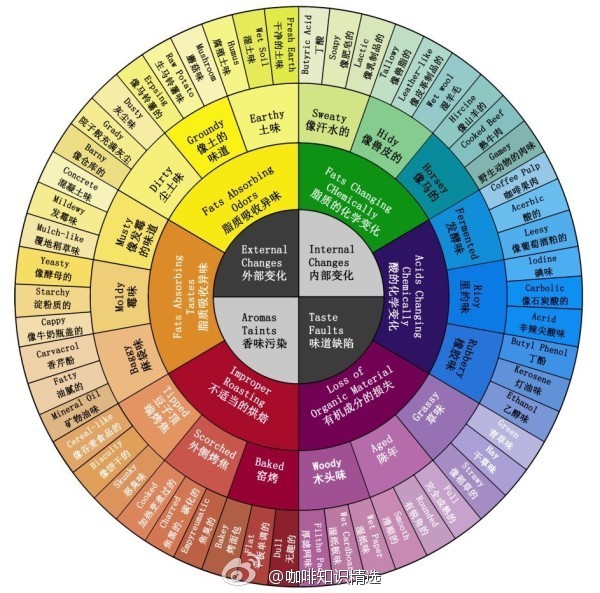Terminology for coffee cup testing
Acidity Acidity: acidity is an essential feature of coffee, which is the feeling of dryness that coffee produces on the sublingual edge and the back palate. The effect of coffee acidity is similar to that of red wine, with a strong and exciting texture. Without enough acidity, the coffee tends to be flat. Acidity is different from sour taste, which is an unpleasant and bad taste feature.

The wet aroma is difficult to separate from the flavor. If there is no sense of smell, our basic sense of taste is only sweet, sour, salty and bitter. The wet aroma enriches the taste discrimination of the soft palate. Some subtle and delicate differences, such as the "floral" or "wine" characteristics, come from the wet aroma of brewed coffee.
Alcohol thickness is the feeling of coffee in the mouth, that is, the feeling of stickiness, thickness and richness produced by coffee acting on the tongue. The difference between drinking whole milk and drinking water is a good example. Our perception of the alcohol thickness of coffee is related to the oil and solids extracted by coffee. The alcohol thickness of Indonesian coffee is significantly higher than that of South and Central American coffee. If you are not sure about the alcohol thickness difference of several types of coffee, try adding the same amount of milk to the coffee. Coffee with high alcohol thickness will retain more flavor when diluted with milk.
Flavor is the overall feeling of coffee in the mouth. Acidity, wet aroma and alcohol thickness are all components of flavor, and it is their balance and homogenization that produce our overall sense of flavor.
Here are some typical flavor characteristics: richness-the thickness and richness of alcohol; complexity-the feeling of multiple flavors; and balance-all the basic taste features are satisfactory, and no one taste masks the other.
Fresh, bright, dry, light or lively-(common in Central American coffee): caramel-like sugar or syrup; chocolate-similar to unsweetened chocolate or vanilla aftertaste; delicious-delicate flavor felt on the tip of the tongue (washed New Guinea Arabica beans); earthy-earthy aroma (typical Sumatran coffee) Fragrant-a fragrant trait, ranging from floral to spicy; fruity-an aromatic trait reminiscent of berries or oranges; sweet and mellow-round, smooth, lack of acidity; nutty-similar to the aftertaste of fried nuts; spicy-reminiscent of the flavor and aroma of various spices; sweet-unastringent Wild-a wild flavor that is generally not considered pleasant; common in Ethiopian coffee; alcoholic flavor-an aftertaste reminiscent of fully ripe wine (common in Kenyan and Yemeni coffee).
Undesirable flavor characteristics: bitter-taste from the root of the tongue, mostly caused by overbaking; boring, non-irritating-neutral; charcoal-with charred carbon; inanimate-with "Flat"; miscellaneous-moldy, reminiscent of eating dirt; earthy-with "miscellaneous" Insipid-sour, lacking wet aroma and aftertaste; grassy-reminiscent of freshly cut grass; rough-a caustic, scratched, rough quality; muddy-sticky but not strong; stiff-starch textured, similar to water cooked with pasta; rough-feel on the tongue, similar to eating salt Rubber smell-similar to burnt rubber smell (commonly found in dry processed Robusta beans); soft-same as "boring, non-irritating"; sour-similar to the acidity of unripe fruit; thin-acidity-free, usually caused by inadequate extraction; turpentine-tasting like turpentine; water-lacking alcohol thickness and no stickiness in the mouth Rough-wild quality.
Important Notice :
前街咖啡 FrontStreet Coffee has moved to new addredd:
FrontStreet Coffee Address: 315,Donghua East Road,GuangZhou
Tel:020 38364473
- Prev

The adjective of coffee
Exotic [uniqueness] describes coffee as having unique aromas and special flavors, such as flowers, fruits and spices. Mellow [aromatic alcohol] is an adjective for coffee with low to medium acidity and good balance. Mild [mild] indicates that some kind of coffee has a harmonious and delicate flavor. Latin American premium coffee grown on the plateau, often described as
- Next

Roast coffee beans
The baking silver skin of coffee beans the basic concept of roasting: coffee beans: familiar with the discrimination and selection of raw beans. Baking pot: familiar with the characteristics, structure and material of the baking machine. Technology: the cultivation of time, degree, temperature control and discrimination ability. The color, aroma and taste of coffee are caused by complex chemical changes in the roasting process. Baking is based on
Related
- Beginners will see the "Coffee pull flower" guide!
- What is the difference between ice blog purified milk and ordinary milk coffee?
- Why is the Philippines the largest producer of crops in Liberia?
- For coffee extraction, should the fine powder be retained?
- How does extracted espresso fill pressed powder? How much strength does it take to press the powder?
- How to make jasmine cold extract coffee? Is the jasmine + latte good?
- Will this little toy really make the coffee taste better? How does Lily Drip affect coffee extraction?
- Will the action of slapping the filter cup also affect coffee extraction?
- What's the difference between powder-to-water ratio and powder-to-liquid ratio?
- What is the Ethiopian local species? What does it have to do with Heirloom native species?

